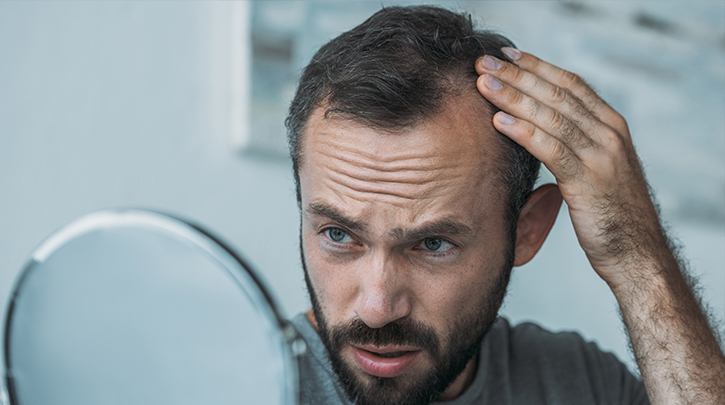
- Global
Get non-surgical solutions for today's top aesthetic concerns with Venus Treatments. Join thousands of satisfied patients worldwide!
- Loading...
- All Regions
Get non-surgical solutions for today's top aesthetic concerns with Venus Treatments. Join thousands of satisfied patients worldwide!

It’s not hard to imagine that hair restoration treatments and technologies have come a long way since the first known hair loss solution was introduced more than 3,500 years ago. The oldest known prescription for baldness dates back to 1550 BC with the application of a complex mixture featuring iron-oxide, onions, honey, alabaster, lead, and an assortment of animal fats, including lion, snake, crocodile, hippopotamus, and more. The results of using this ancient mixture are undocumented, but we’re confident in assuming that today’s technologies are much more likely to afford better results in a much safer way.
Still, not all hair restoration treatments are equal, even today. Treatment plans, durations, follow-up care, and results, among other factors, can all vary widely between treatments and technologies, but which may offer the best outcome for your aesthetic goals? Here, we explore today’s most popular hair loss treatment options alongside those just starting to see more interest in 2019.
Minoxidil was the first drug treatment approved by the United States Food & Drug Administration (FDA) for hair loss and remains one of the most commonly prescribed topical treatments for hair restoration. Usually offered in a shampoo or topical serum, minoxidil-based hair care may be the first thing a doctor prescribes if you’re just starting to experience hair loss or thinning. When used properly—following the directions really matter here—minoxidil-based treatments can slow hair loss, though they are less likely to stimulate new hair growth.
Finasteride is another drug-based topical hair loss treatment that your doctor may prescribe, but only if you’re a male. At its core, finasteride’s effects work by directly impeding testosterone hormones from creating DHT, the androgen hormone that’s usually the culprit behind decreased hair growth. Because finasteride works on testosterone alone, this is not the best treatment option for females experiencing thinning or hair loss.
For women, minoxidil is the most suitable topical treatment, but know that it offers the best results when it’s used to complement another hair loss solution. It’s worth underscoring that these drug-based hair loss treatments are only effective if used properly and consistently. Skipping out on applications may render these products ineffective and stopping use altogether will result in continued hair loss, meaning you’ll miss out on any gains you experienced while using it.
If you’ve heard of PRP therapy before, it was likely in reference to a new facial. Platelet-rich plasma (PRP) therapy works by using your own blood plasma to stimulate healthy cell renewal. How exactly does this work? First, note that your blood contains two major components: red blood cells and plasma. Plasma can be broken down into two further components: white blood cells and platelets. Platelets are the component that is rich in growth factors, which are essentially little messengers that tell skin cells to regenerate or, in the case of hair restoration, tell dormant hair follicles to get growing.
Still in the early stages of research, hair cloning may eventually offer an ideal way to stimulate inactive hair follicles to encourage regeneration and new hair growth. Essentially, in hair cloning, healthy hair follicles are extracted and grown in a lab, sometimes using artificial skin as a temporary base for growth. Once hair growth occurs, the hairs are extracted and recombined with living skin cells to create new active hair follicles. In simpler terms, hair cloning duplicates healthy hair follicles. This offers a greater yield of transplants with fewer extractions. Unfortunately, because the treatment is still being tested, we’re at least a few years out from seeing if it really can be an effective hair loss solution. For now, it’s an interesting option to keep an eye on.
Hair restoration procedures focus in on the transplantation of healthy hair follicles from areas where hair is thicker, like the back and sides of the head, to areas where hair is typically thinner, which is usually towards the top of the head. Having evolved since the late 1980s, when massive grafts of 12–20 hair follicles were transplanted, today’s hair restoration treatments utilize smaller grafts for more natural-looking results.
Generally speaking, hair restoration procedures can be divided into two classifications based on method: Follicular Unit Transplantation (FUT) and Follicular Unit Extraction (FUE). Both methods first extract hair follicles from the back and side of the head, where the scalp and hair are usually more resistant to the effects of DHT, the hormone that is usually at the root of your thinning hair concerns. However, there are a couple of key differences to note between FUT and FUE procedures.
With FUT procedures, your physician will use a scalpel to remove a strip of hair from the scalp where growth is thicker. Your treatment provider will then divide this strip into smaller units to be implanted in the areas of the scalp where hair is thinning. FUT can be an effective hair restoration treatment, but it is also a much more invasive procedure that often leaves behind a long, linear scar where the strip was removed. FUT treatments also require a longer recovery period post-treatment.
In comparison, during your typical FUE procedure, your treatment provider will extract naturally-occurring groups of hair follicles in smaller grafts, rather than removing a long strip. Each group contains one to three hairs, on average. These smaller grafts are then sorted to make it easier for your treatment provider to create a natural-looking hairline during implantation. With this method, your treatment provider is also able to better implant hairs at an angle that best matches the way your hair naturally grows. The FUE method is minimally invasive, leaves no linear scarring, and offers a quicker recovery period—all key benefits for those who may be unable to take too much time away from their busy schedule.
Adding to the advanced FUE transplant method, the NeoGraft® hair restoration system makes use of controlled pneumatic pressure that allows your treatment provider to more smoothly and gently extract hairs. Along with making it more comfortable for you, the hair follicles are more likely to survive implantation as a result of this gentler extraction method. The system also supports real-time graft counts, which helps your treatment provider determine when enough hairs have been extracted, preventing any unnecessary extractions. With these advanced features, you’re able to reach your aesthetic goals in less time with no linear scarring and minimal downtime. This gives you greater freedom in the hairstyles you choose post-treatment and minimizes the impact that your complete treatment plan will have on your schedule.
Regardless of which hair restoration method you choose, the first step is to ensure you are using an experienced, certified treatment provider who starts with a thorough consultation to determine whether you are the right candidate for the procedure. They should also be able to give you a realistic idea of the results you can expect with quality before-and-after pictures. When you’ve found a provider that you’re comfortable with for your treatment of choice, you’ll be able to rest assured knowing that you’re taking the first step to revealing the new you!
Find a certified Venus Treatments provider near you today who specializes in today’s top aesthetic medical solutions.



Search below to find a provider near you and to learn about our non-surgical aesthetic treatments with ARTAS®, NeoGraft®, Venus Bliss™, Venus Blilss MAX™, Venus Versa™, Venus Legacy™ Venus Versa™ Pro, Venus Velocity™, Venus Viva™ MD, and Venus Glow™.
For more information call: (888) 907-0115 // [email protected] // 235 Yorkland Blvd., Suite 900, Toronto, ON, M2J 4Y8 Canada
REGULATORY CLEARANCES [ More ]
Venus Bliss™ is cleared by the FDA and licensed by Health Canada for non-invasive lipolysis of the abdomen and flanks in individuals with a Body Mass Index (BMI) of 30 or less, with the diode laser applicators. The (MP)2 applicator is cleared by the FDA for temporary reduction in the appearance of cellulite, and licensed by Health Canada for temporary increase of skin tightening, temporary circumferential reduction, and temporary cellulite reduction. Venus Bliss™ has CE Mark as a non-invasive medical aesthetic device enabling a comprehensive approach leading to body contouring, addressing fat reduction, skin tightening, circumference reduction, and cellulite reduction.
Venus Versa™ is cleared by the FDA, licensed by Health Canada, and has CE Mark as a multi-application device intended to be used in aesthetic and cosmetic procedures. The SR515 and SR580 applicators are cleared by the FDA, licensed by Health Canada, and have CE Mark for the treatment of benign pigmented epidermal and cutaneous lesions and treatment of benign cutaneous vascular lesions. The HR650/HR650XL and HR690/HR690XL applicators are cleared by the FDA, licensed by Health Canada, and have CE Mark for the removal of unwanted hair and to effect stable long-term or permanent hair reduction for Fitzpatrick skin types I-IV. The AC Dual applicator is cleared by the FDA, licensed by Health Canada, and has CE Mark for the treatment of acne vulgaris. The DiamondPolar™ and OctiPolar™ applicators on the Venus Versa™ system are cleared by the FDA for non-invasive treatment of moderate to severe facial wrinkles and rhytides on females with Fitzpatrick skin types I-IV. The DiamondPolar™ applicator is licensed by Health Canada and has CE Mark for non-invasive treatment of moderate to severe facial wrinkles and rhytides on females with Fitzpatrick skin types I-IV. The OctiPolar™ applicator on the Venus Versa™ system is licensed by Health Canada and has CE Mark for temporary body contouring via skin tightening, circumferential reduction, and cellulite reduction. The NanoFractional RF™ (Viva) applicator is cleared by the FDA, licensed by Health Canada, and has CE Mark for dermatological procedures requiring ablation and resurfacing of the skin.
NeoGraft® is cleared by the FDA, licensed by Health Canada and has CE Mark with indication for use in suction-assisted follicular extraction and re-implantation. It is an auto-graft system and can be used on both male and female patients.
ARTAS iX™ is cleared by the FDA, licensed by Health Canada and has CE Mark with indication for use for harvesting hair follicles from the scalp in men diagnosed with androgenic alopecia (male pattern hair loss) who have black or brown straight hair. ARTAS iX™ is intended to assist physicians in identifying and extracting hair follicular units from the scalp during hair transplantation; creating recipient sites; and implanting harvested hair follicles.
Venus Legacy™ is cleared by the FDA for the non-invasive treatment of moderate to severe facial wrinkles and rhytides in females with Fitzpatrick skin types I-IV with the OctiPolar™ and DiamondPolar™ applicators, and temporary reduction in the appearance of cellulite with the 4D Body (LB2) and 4D Face (LF2) applicators. It is licensed by Health Canada and has CE Mark for the temporary increase of skin tightening, temporary circumferential reduction, temporary cellulite reduction, and temporary wrinkle reduction.
Venus Velocity™ is cleared by the FDA, licensed by Health Canada and has CE Mark for hair removal, permanent hair reduction (defined as the long-term stable reduction in the number of hairs re-growing when measured at 6, 9 and 12 months after the completion of a treatment regimen), and the treatment of pseudofolliculitis barbae for all Fitzpatrick skin types.
Venus Fiore™ received regulatory approval in Israel for aesthetic and functional treatment of the vagina, labia and mons pubis. Venus Fiore™ is available for sale in India, Hong Kong, and other selected Asian countries.
Venus Viva™ is cleared by the FDA, licensed by Health Canada, and has CE Mark for dermatological procedures requiring ablation and resurfacing of the skin. The DiamondPolar™ applicator is cleared by the FDA, licensed by Health Canada and has CE Mark for the treatment of moderate to severe wrinkles and rhytides in Fitzpatrick skin types I-IV.
Venus Freeze Plus™ is cleared by the FDA for the non-invasive treatment of moderate to severe facial wrinkles and rhytides in females with Fitzpatrick skin types I-IV. It is licensed by Health Canada for temporary skin tightening, and temporary reduction in the appearance of cellulite on the abdomen and flanks, using the DiamondPolar™ and OctiPolar™ applicators. The DiamondPolar™ applicator on Venus Freeze Plus™ has CE Mark for the non-invasive treatment of moderate to severe facial wrinkles and rhytides, and the increase of skin tightening, temporary circumferential reduction, and cellulite reduction with the OctiPolar™ applicator.
Venus Heal™ is licensed by Health Canada and can be used for the treatment of both acute and chronic disorders of the musculoskeletal system, such as muscle spasms, back pain, and soft tissue injuries, and results in effects such as pain relief, myorelaxation, increase of local blood circulation, and edema reduction. In the U.S., Venus Heal™ is cleared by the FDA for the relief of minor muscle aches and pain, relief of muscle spasm, and temporary improvement of local blood circulation. These indications enable the treatment of certain soft tissue injuries and conditions.
Venus Glow™ is cleared by the FDA as a Class I motorized dermabrasion device. It provides a dermal rejuvenation treatment that works to open up and deep-clean pores. Venus Concept is the exclusive distributor for Venus Glow™.
Venus Epileve™ is licensed by Health Canada and has CE Mark for hair removal, permanent hair reduction (defined as the long-term stable reduction in the number of hairs re-growing when measured at 6, 9 and 12 months after the completion of a treatment regimen), and the treatment of pseudofolliculitis barbae for all Fitzpatrick skin types. Venus Epileve™ is also CE-Marked for hirsutism.
Venus Freeze™ is cleared by the FDA for the non-invasive treatment of moderate to severe facial wrinkles and rhytides in females with Fitzpatrick skin types I-IV. It is licensed by Health Canada for temporary skin tightening, and temporary reduction in the appearance of cellulite on the abdomen and flanks, using the DiamondPolar™ and OctiPolar™ applicators. The DiamondPolar™ applicator on Venus Freeze™ has CE Mark for the non-invasive treatment of moderate to severe facial wrinkles and rhytides, and the increase of skin tightening, temporary circumferential reduction, and cellulite reduction with the OctiPolar™ applicator.
Venus Swan™ is cleared by the FDA for the non-invasive treatment of moderate to severe facial wrinkles and rhytides, and licensed by Health Canada for the non-invasive treatment of cellulite reduction, skin tightening, and temporary reduction in the appearance of stretch marks.
Copyright © 2024 Venus Concept. All rights reserved.
You are entering our website. For other countries/regions and language options, please click the SELECT A DIFFERENT REGION button below.
SELECT A DIFFERENT REGIONAre you looking to get a treatment? Please visit our patient website to learn more.
Click HereUnsure which aesthetic treatment is right for you? Take this quick and easy quiz to discover treatments that suit your needs.
Get Started